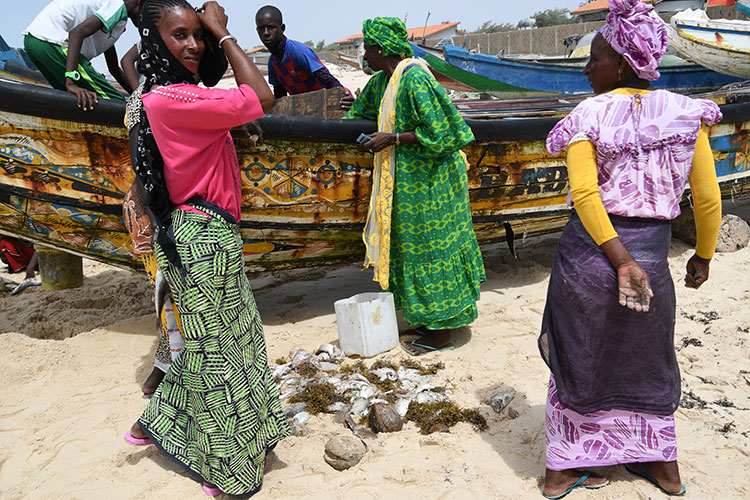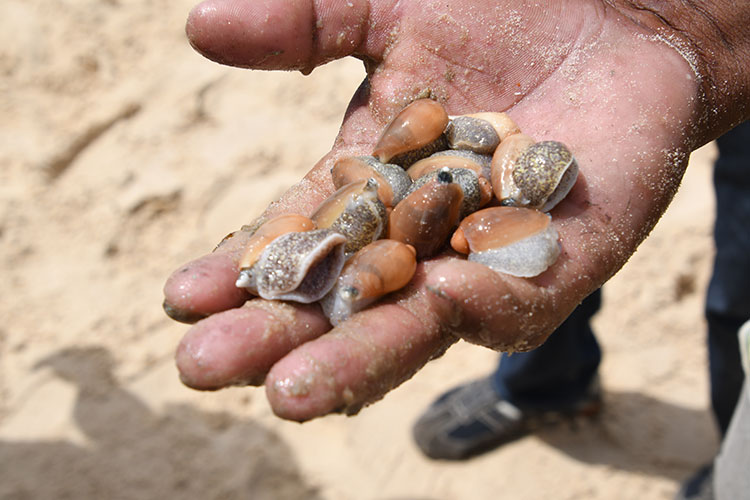3.1.2 Recruiting new resources
There are two ways to encourage the recruitment of new resources: (1) the protection of spawning fish, such as the establishment of no-fishing seasons, resource protected areas and limited fishing zones, and (2) the creation of spawning grounds and the protection of small immature fish, such as the release of immature fish and the regulation of fishing gear for immature fish. This section introduces the procedures and methods used to recruit new stock.
- Understand coastal topography and distribution of coastal resources
- Develop an activity plan to promote the recruitment of new resources
- Establish a timetable of activities and rules for implementation, and obtain the understanding of stakeholders
Understand coastal topography and distribution of coastal resources.
Fisheries resource management organisations assess the coastal topography (such as mangroves, sand and mud beaches, rocky shores, seagrass beds, and reefs) and the distribution of coastal resources in the target communities through interviews and field surveys.
12. How to determine the coastal topography and distribution of coastal resources
The topography of the coast and seabed of the target area, as well as the nature of the seabed and the depth of the coastal waters, are indicated on the nautical charts covering the target area. Based on this information, fishermen who have been fishing an area for many years are interviewed to find out which fish species they catch, in which season and area, the distribution of fish species and seasonal fluctuations in catches, the quantity of fish caught, and the evolution of the length of the fish caught from the past to the present. The knowledge of fishermen who have been fishing in the area for many years often provides accurate and valuable information based on on-site perception.
Develop an activity plan to promote the recruitment of new resources.
With the information collected, the resource management organisations consult with the Fisheries Directorate to discuss measures to promote the recruitment of new fisheries resources and formulate a draft activity plan. In general, measures to promote the recruitment of new fishery resources, such as protection of spawning stock and protection of small immature fish, are as follows:
Protection of spawning fish: To protect spawning fish during the spawning season to encourage recruitment of new fisheries resources and make spawning grounds limited fishing areas.
⚫︎ Establishing the closed season for fishing:
13. Management of cymbium resources through implementation of the closed season
A study on the assessment and planning of fisheries resources management conducted by JICA between 2003 and 2006 made it possible to set a closed season when there are many juvenile cymbium and the seeding of juvenile cymbium. These activities were taken over by COGEPAS, which started in 2009. New workshops were organised mainly for the Joal CLPA and its members joined the activities of Sindia CLPA, which had already implemented a closed season and spat enclosure to conduct similar activities since 2010. In 2011, the CLPA of Mbour joined the project and the three CLPAs developed an extended fisheries resource management.
⚫︎ Establishment of resource protected areas and limited fishing zones:
21. The history of the establishment of Senegal’s first marine protected area
The Bambooing Marine Protected Area consists of the Bamboung Channel and surrounding mangrove forests in the Saloum Delta of central Senegal, a well-known fish spawning area. In 2001, the community of the village of Toubacouta, in the presence of the governor of the department of Foundiougne and the chief of the district of Toubacouta, adopted a proposal to establish Senegal's first MPA, initiated by the Senegalese environmental NGO Oceanium. It was subsequently recognised as a national MPA by Decree No. 2004-1408 of 4 November 2004.
⚫︎ Creation of spawning grounds:
14. Octopus resource management using octopus pots for spawning
Fisherman-led octopus resource management started in 2004 in the village of Nianing on Senegal’s Petite-Côte, as a pilot project of the JICA study on fisheries resource assessment and management planning. After successfully establishing a closed season for octopus fishing, the fishers continued their experimentation by installing octopus pots for spawning. In 2006, it was found that 50% of the octopus pots placed at the bottom of the sea contained octopus eggs and 75% of the pots contained octopus. The project demonstrated the effectiveness of placing octopus pots for spawning as a means of creating a favourable environment for octopus reproduction. With these results, octopus resource management also started in the neighbouring villages of Pointe Sarène and Mballing.
15. Introduction of artificial laying beds for cuttlefish
In Djifer in the Petite-Côte a region of Senegal, cuttlefish (Sepia lycidas) is an important product, accounting for 26% of the total value of the catch. In recent years, however, cuttlefish catches in Djifer have declined and the size of the caught cuttlefish has become smaller. In Djifer, cuttlefish are caught in traps and the branches attached to the traps serve as spawning places for cuttlefish, making the trap fishery a resource management fishery. COGEPAS has worked to promote the increase of the cuttlefish stock through the use of spawning beds.
Protection of small immature fish: Protecting juveniles and young fish and reducing stock loss
⚫︎ Release of immature fish:
16. Cymbium resource management through spawning
The company ELIM PECHE, which buys cymbium from Joal, was catching hundreds of juvenile cymbium daily during the spawning period. The CLPA of Joal therefore decided to collect and return these to the sea. The COGEPAS project confirmed that the effectiveness of fisheries resource management activities could be enhanced by the cooperation of the fishing company with which CLPA has a commercial relationship.


⚫︎ Regulation of fishing gear for immature fish:
17. Limiting the mesh size of bottom-set gillnets to avoid catching immature fish
The Lompoul CLPA decided to increase the mesh length of the bottom set gillnets used locally to 40 mm and reduce the number of gears used. Supported by the JICA COGEPAS project, they formulated a bottom set gillnet management plan in December 2010. The Bottom Gillnet Resource Management Committee was established to verify that (1) the net mesh sizes specified in the management plan were used and (2) the reduced gear was returned to the Fishing Centre.
Establish a timetable of activities and rules for implementation, and obtain the understanding of stakeholders.
The resource management organisations explain the draft business plan they have developed to the concerned coastal fishermen and invited them to cooperate. With the collaborators, the draft activity plan is discussed in detail and a schedule of activities and draft implementation rules are drawn up. The draft plan will be explained to the residents of the target community to obtain their understanding. If consensus is not obtained, the plan will be revised accordingly and discussions held as many times as necessary until the community understands. If necessary, resource management organisations ask the government and donors to provide the necessary funds and equipment. Additionally, signboards, posters, and leaflets describing the activities will be developed to publicise them and raise awareness.
18. Use of ecological characteristics of target species to promote resource enhancement
When conducting resource management activities to promote the recruitment of new fisheries resources, it is effective to target fish species with the following ecological characteristics.
- ・Fish species that lay sinking and sticky eggs: In the case of floating eggs, ocean currents can spread eggs away from the target site.
- ・Fast-growing fish species: Species that grow slowly and take a long time to reach adulthood are less likely to show results.
- ・Highly sedentary fish species: Species that are highly migratory will disperse outside the target site. However, fish species that migrate seasonally and grow rapidly may show an increase in their stocks in the following year's migration.
